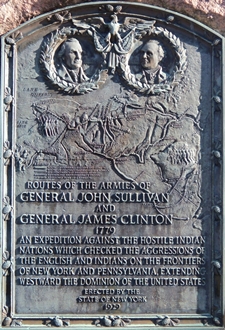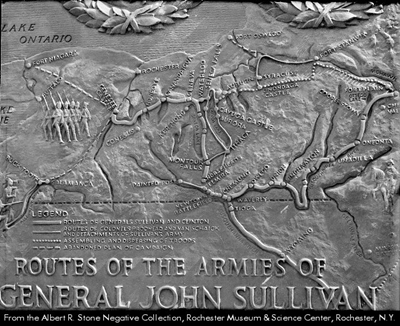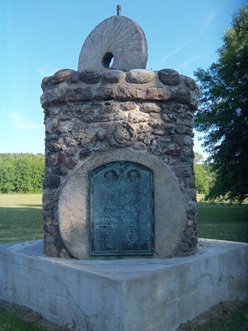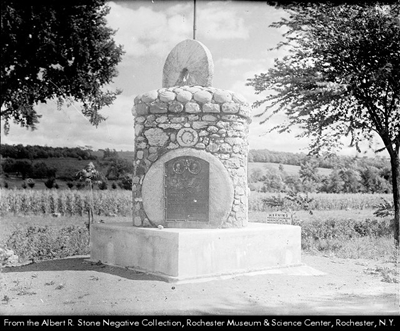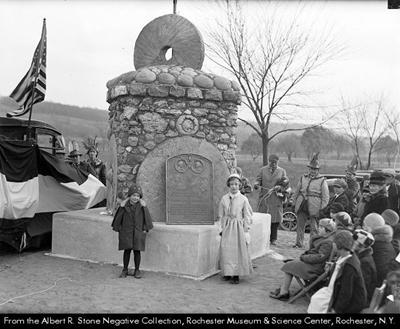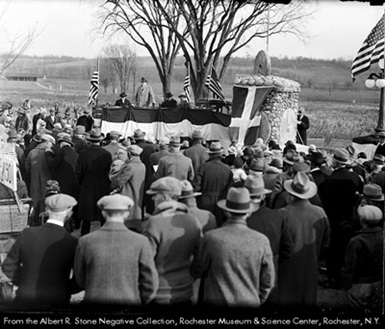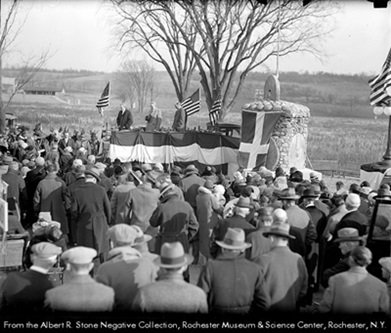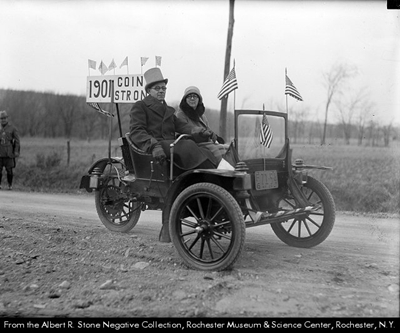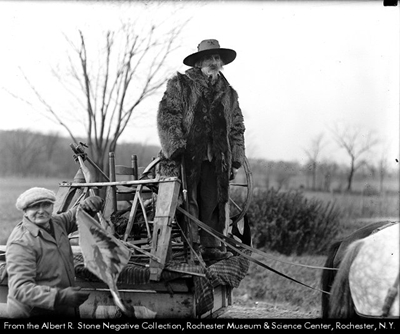|
|
General Sullivan’s March has been commemorated by the erection and dedication of a memorial at the point on the foot of Hemlock Lake where his army passed 150 years ago.
Judge Westbury presided at the ceremonies and an address was delivered by the Honorable James W. Wadsworth.
As the afternoon sun tried to mitigate the cold rawness of the November west wind for the several hundred men and women who paid tribute to the memory of General John Sullivan at the Hemlock lake park last Saturday, they visualized, through the vivid word picture drawn by former Senator Wadsworth, the march of Sullivan and his 4,000 veteran soldiers from the time they started from Easton, Pa., on their mission until they returned victors. The passing of that army at the foot of Hemlock lake 150 years ago was celebrated Saturday afternoon by the dedication of a monument at the entrance to the park.
Months ago Alva Reed of Richmond had the happy idea of commemorating the historic march throught the town of Livonia by erecting a monument in the park. After a vast amount of time and effort, which can be appreciated only by him and those who helped him bring the idea to fruition, the dream was realized, and there stands now a the park entrance a monument which the state historian, Alexander C. Flick, characterizes as “unique among the monuments of the state of New York.”
The monument was designed by Henry A. Kunze, superintendent of the Rochester watershed, the material which went into its construction was donated by local residents, and it was erected by the City of Rochester. It is one of the most original and expressive markers in the country.
It stands nearly fourteen feet high, is capped with an old mill stone, while four others form the four faces of the memorial. These five stones, as well as others which will be used in further embellishments of the base, came from old local gristmills and were given by local residents. Four of the five were taken from the old Beam mill at Canadice outlet, and were given by the City of Rochester. Others were given by E. H. Westbrook, L. L. Short, B. W. Naracong, William White, H. A. Kunze, Nelson Jennings and L. W. Hoppough. The cap-piece is a mill stone set on edge, while immediately back of it rises a flagstaff. Indian relics, including tomahawks and scores of arrowheads collected largely by Alva Reed, and many different kinds of stones, all of which were found in the neighborhood, were used in the construction of the monument. They have been set in black cement.
The shaftholes in three of the face millstones have been filled with a clay formation native to the section, while the hole in the fourth, that facing the north, was left open for the insertion of a copper box, which should contain, inscribed on architect’s linen, the signatures of those responsible for the monument, the signatures of the speakers of the day, a copy of the printed program, copies of the Livonia Gazette, and other articles of historic value. After this box is placed within the monument, the large bronze plaque, such as is seen on all of the Sullivan memorials throughout the state, will be sunk in the millstone, closing the opening. The millstone on the park side bears a modest plaque, bearing the legend:
Erected by the City of Rochester 1929
Material Donated by Local Residents
Designed by Henry A. Kunze
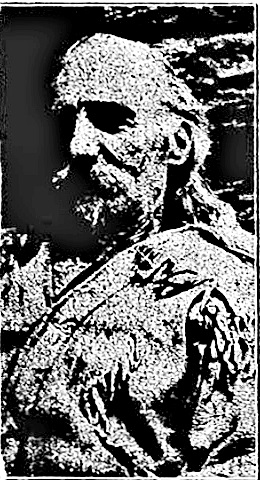
13
Bradley Adams of Hemlock was one of the prominent figures at the dedication of the Sullivan monument at Hemlock Lake Park last Saturday.
The program of the afternoon was preceded by a parade, which was as unique as the monument. It portrayed the history of days long past at the same time that it told a contrasting story of the present. Included in the parade were a Rebekah float, driven by Dudley Reed, the Rebekah characters being represented by Mrs. Frank Van Buren, Mrs. Harvey Hill and Mrs. Samuel Collins; a wagon load of women clad in old-fashioned costumes, consisting of Marguerite Collins, Carol Paradise, Fay Agard, Muriel Rogers, Burrel Mather, Mildred Blank, Blanche Capron, Mabel Ace, Thelma Hoppough, Lois Giggs, with Harry Fraser the driver. Lew Hoppough drove a team hitched to an old lumber wagon, and seated beside him was Bradley Adams, lending color to the scene. In the wagon were also an ancient corn planter, an old-fashioned lantern and spinning wheel, while the cars occupied by the driver and his companion were the kind used decades ago.
Alva Reed and Riley Ward, “old fiddlers”, sailed by in a truck playing, respectively, the banjo and fiddle, while with them were Mr. and Mrs. Willard Schoonover and daughter, dressed in keeping with customs of many years back. Mr. and Mrs. Carl Scutt of Hemlock appeared in their interesting three-wheeled 1901 Motorette, while Beam Milling Co, Reed & Reed, C. E. Wemet & Co., George Powell and others had trucks in the procession displaying their products. The Odd Fellows’ roast pig supper was duly advertised by a truck bearing a table on which was young Mr. Porker himself, while around the table sat a group of people advising the public of the event.
Members of the local lodge of Red Men were present in costume, and the Boy Scouts and school children were also present. The procession to the park was lead by the boys’ band of Industry.
At the opening of the program “America” was sung under the direction of Principal C. E. Chauncey of the Hemlock high school, and the invocation was pronounced by the Rev. G. H. Nelson of the Hemlock Methodist church.

14
Judge Westbury of Rochester, whose boyhood days were spent in Hemlock.
In the absence of Judge Lockwood Doty, the chairman of the day was Judge Raymond Westbury of Rochester. He spoke of his attachment for Hemlock and his affection for the people of this section, for here was where he spent his boyhood, learned many of the elemental principles of life and developed enduring friendships. The old gate house was his home for many years.
Besides Judge Doty, other scheduled speakers unable to be present were: William A. Wheeler, county judge of Livingston county; Dr. Flick, state historian; Dr. Arthur C. Parker, director of the Rochester municipal museum, and John T. Fetherston, president of the Livingston County Historical society.
Senator Wadsworth delivered a graphic address, explaining in detail the causes and objects of the Sullivan expedition, and elaborting upon the incidents and results of the memorable and important march as it accomplished the purpose for which it was planned and executed.
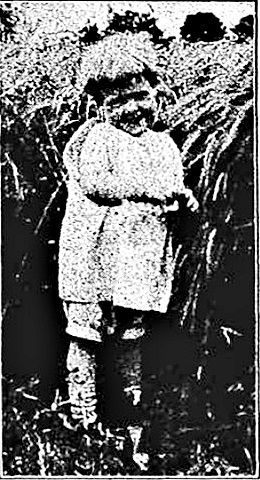
15
Marion Reed who with Geraldine Beam unveiled the monument.
Following the address, the tablet on the monument was unveiled by two little girls: Marion Reed, daughter of Mr. and Mrs. Dudley Reed, and Geraldine Beam, daughter of Mr. and Mrs. Floyd Beam. Marion Reed is of the sixth generation of her family, her great-great-great-grandfather having been Philip Reed, who came from Vermont and settled in Richmond in 1797.
Geraldine Beam is also a representative of the sixth generation of her family which has lived in Hemlock. In the last quarter of the eighteenth century Philip Short came to this section from Massachusetts and settled several hundred acres of land, included in it being the property which is now Hemlock lake park. He was the great-great-great-grandfather of Geraldine Beam.
The benediction was pronounced by the Rev. John Smith, pastor of St. Michael’s church at Livonia Center. The singing of “The Star Spangled Banner” concluded the program.
|
|


